27 April 1778 Monday
Vases, Candelabra, Grave Stones, Sarcophagi. Tripods, Lamps and Ancient Ornaments volume II
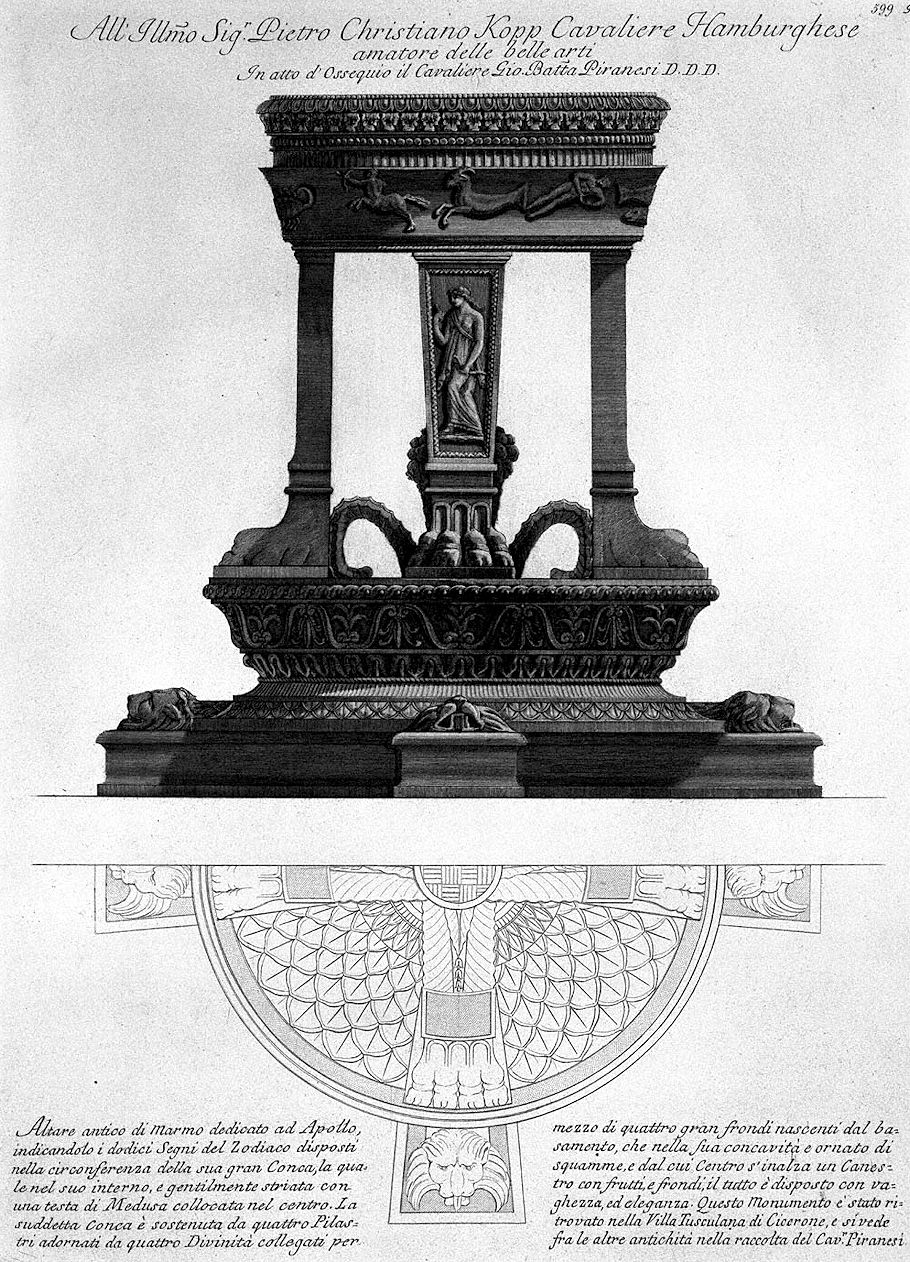
To the most Ill(ustrix) Mr. Pietro Christiano Kopp Knight of Hamburg
lover of fine arts
In deed of respect the Cavalier Gio. Batt(ist)a Piranesi D. D. D.
Ancient marble altar dedicated to Apollo, indicated by the twelve signs of the zodiac arranged in the circumference of its large basin, which inside is gently streaked with a head of Medusa placed in the center. The aforementioned Basin is supported by four Pillars adorned by four Divinities connected by means of four large fronds emerging from the base, which in its concavity is decorated with scales, and from whose Center rises a Basket with fruits and fronds, the whole is arranged with vagueness, and elegance. This monument was found in Cicero's Villa Tusculana, and can be seen among other antiquities in the collection of Cav.r Piranesi.
24-25 y.o. Francesco Piranesi 1783
Collezione delle piu belle statue di Roma
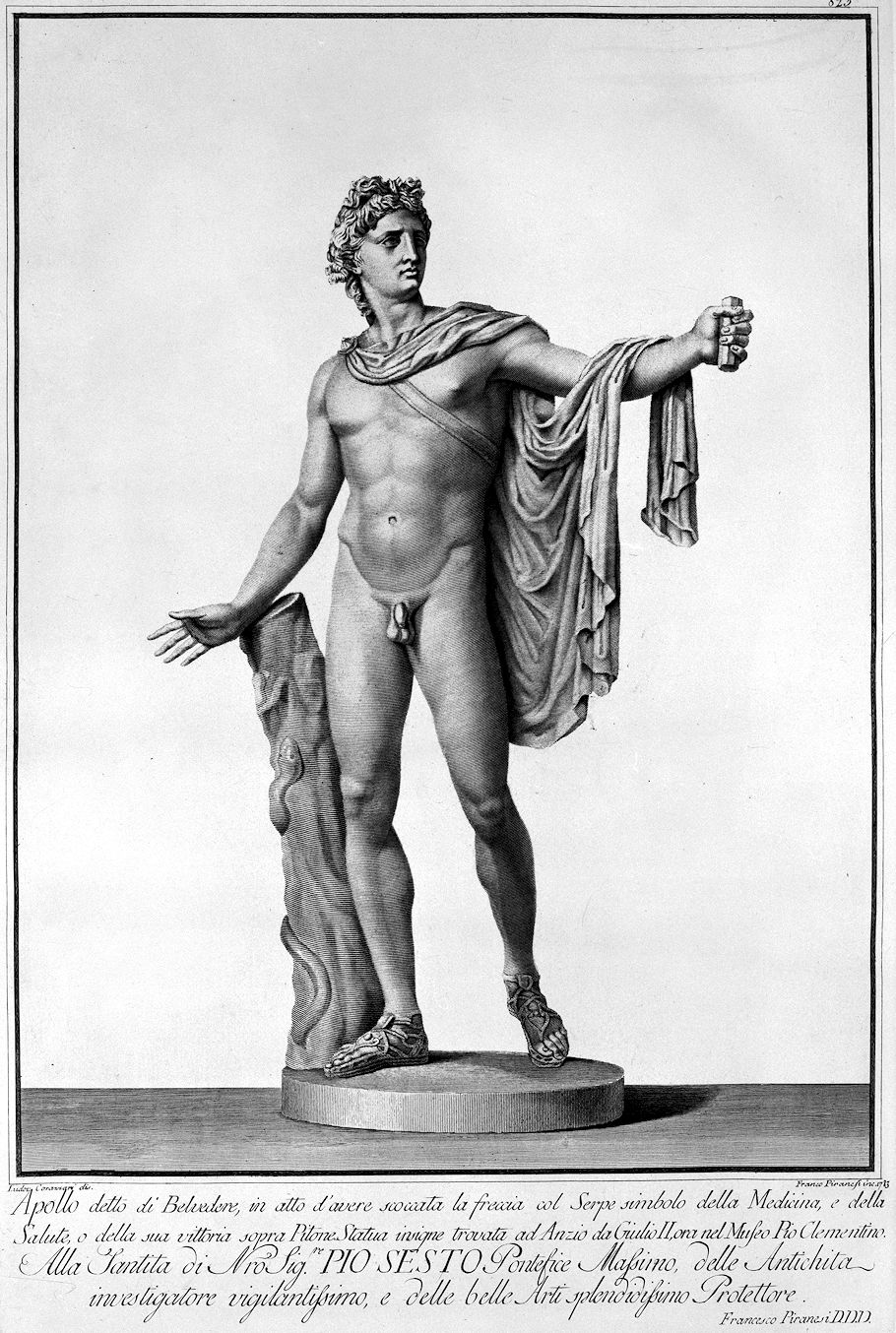
Apollo known as Belvedere, in the act of having shot the arrow with the Serpent symbol of Medicine, and of Health, or of his victory over Python. Insignificant statue found in Anzio by Julius II, now in the Pio Clementino Museum. To the Holiness of Our Lord PIO SEXTUS Pontifex Maximus, most vigilant investigator of Antiquities, and most splendid Protector of the fine Arts.
Francesco Piranesi D.D.D.
Ludou Corazzari drawn Francesco Piranesi engraved 1783.
27 April 1812 Monday
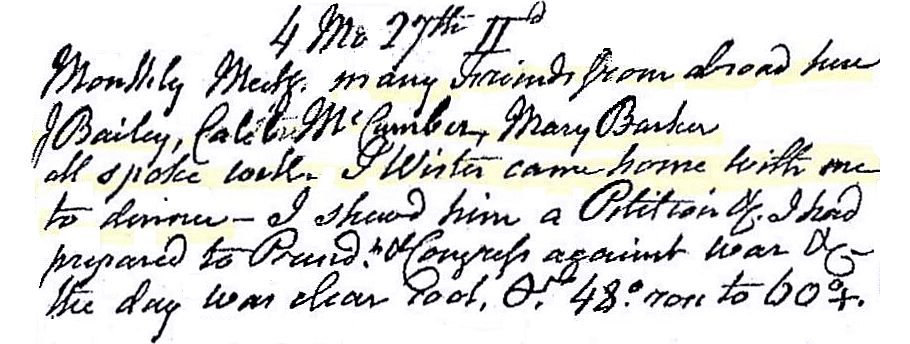
Monthly Meeting, many Friends from abroad here. J Baily, C..... McCumber, Mary Barker all spoke well. T. Wister came home with me to dinner. I showed him a petition etc. I had prepared to President and Congress against war. The day was clear, cool. Temperature 48° rose to 60°+.
27 April 1998
new insights regarding the Campo Marzio Busti
As I am proceeding with translating all the Latin labels of the Ichnographia, I've developed some new ideas regarding the Bustum Hadriani and the Bustum Augustus. I never compared and contrasted them before, but I now see that Piranesi treated them as opposites of each other. The development of this notion ran as follows:
I was today finally able to translate Piranesi's label of the radiation triangular clitoporticus of the Bustum Hadriani--a porticus dedicated to the evocation of the gods and the spirits of the Lower World. Of course, such a porticus fits perfectly with the axis of death, and this axis is also further reinforced by my now knowing the correct meaning of the Bustum (burning place) and also knowing about the slab for the burning bodies and the funeral-pyre. Moreover, the design of the clitoporticus directs all focus upon the place of burning, and it is easy to imagine the wailing that would emanate from this place--it is interesting to match the raising of wailing voices from the clitoporticus with the raising of smoke from the cavea bustum. The whole Bustum Hadriani, now more than ever, comes across as exceedingly morbid, and, ironically, it seems that the burning of the dead within the Bustum Hadriani is treated as a spectator sport, especially with the grandstands of the cavae bustum.
Next, I began to translate the labels of the Bustum Augustii, and here I found the exact opposite wording--the joyful recollection of Augustus. The evocation of joy is certainly the opposite of evoking the spirits of the underworld, and it was this sharp contrast that led me to notice all the other contrasts between the Bustum Hadriani and the Bustum Augusti.
The list of contrasts is as follows:
a. where Hadrian's clitoporticus funnels inward, Augustus' memoriae fans outward.
b. where the Hadrian precinct is square, the Augustin precinct is round.
c. the Hadrian Bustum proper is a "depression," where the Augustan Bustum is "uplifting," raised on a hill.
d. the center of the Bustum Hadriani is fire and the center of the Bustum Augustii is water.
e. the Bustum Hadriani is surrounded by a canal (moat) and the Bustum Augustii is surrounded by a wall.
f. the Bustum Hadriani, with its circuses, is open to all, where the Bustum Augustii, with its iron gate, is closed.
g. where the Bustum Hadriani has a fair degree of archeological veracity, the Bustum Augustii is full of blatant misplacements.
In simple allegorical terms, the Bustum Augustii reenacts the "rise" of Rome, and the Bustum Hadriani reenacts the "fall" of Rome, which is just another inversion derived from a whole set of inversions. The notion of "rise" and "fall," moreover, can be seen in the phallic porticus of the Bustum Augustii versus the Arch of Gratian, Valentinian et Theodosius, which represents the last Roman triumph along with the end of the unified empire.
I never expected to make this type of discovery, and this certainly is an important one because it encompasses the Campo Marzio's two largest complexes, and the two Imperial mausoleums. It is also important because of all Rome's history, pagan, Christian, and Imperial are allegorically represented in the plan. Furthermore, it is now clear through the designs of the two Busti that Piranesi was very consciously drawing and designing the Ichnographia allegorically with a full knowledge and understanding of Rome's history and its archeology. It is almost as though the design of the Bustum Augustii is Piranesi's own expression of joy in evoking the glories of Augustan and Imperial Rome at its best.
Along with this new discovery, I now also know that Hadrian basically built his mausoleum because the mausoleum of Augustus was full, and this is just another example of how pretty much everything has its reason for happening.
27 April 2001
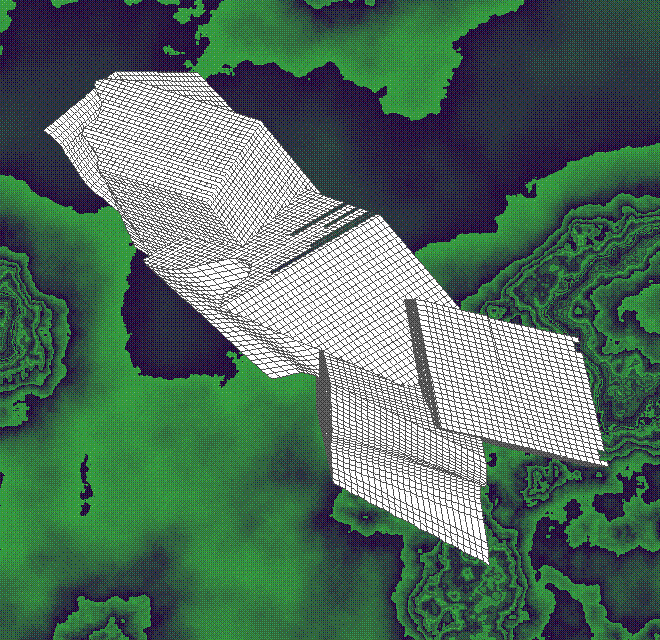
Quaestio Abstrusa background 175
27 April 2008
Happy Birthday Jim!
Apparently, for some, new history is a mystery.
I say their object is definitely academic. As in, so the question, so the answer.
27 April 2023 Thursday
Hello Yura,
I have to immediately apologize to Katya for my comment—“that I now know what it would feel like to look into a mirror and then realize that you're not actually looking at yourself, lol.”
I saw her painting as a collage she thought up and first processed via Photoshop or something, and not till this morning did I ‘discovery’ that her portrait is in fact based on an image I actually took myself!
What I initially saw and thought was:
“Oh, she enmeshed me with Duchamp, that’s clever and insightful.”
“Oh my gosh, she has me wearing one of my brother’s shirts, even with his suspenders. How did she even know that?
“That’s not my head. I bet that’s Yura.”
I woke up this morning really worried that I said/wrote the wrong thing about Katya’s portrait, so I started to reanalyze it. I first had to see it as a painting because I always saw an actual collage.
“How did Katya figure out how to make all those reflections look so real?”
“Those aren’t suspender; they’re camera straps, but I never take pictures with the straps hanging down like that.”
“Yura must have posed for this this picture.”
“I know where Katya got my hands holding the camera, it’s the one where I’m reflected in the chrome bathtub at the PMA.”
“I have to find the picture I must have taken of Duchamp’s coffee grinder.”
Then I found the image, taken by me at the Philadelphia Museum of Art 5 November 2000, that Katya’s portrait is based on.
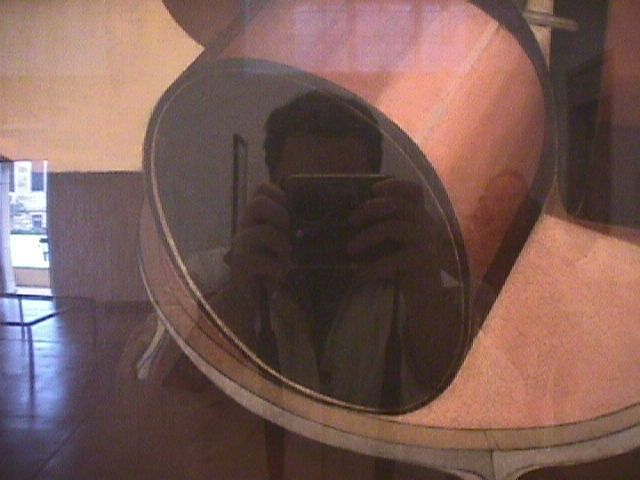
I honestly forgot completely about that image, and now, comparing it with Katya’s portrait, I have to say that Katya certainly has a real gift for making portraits look alive.
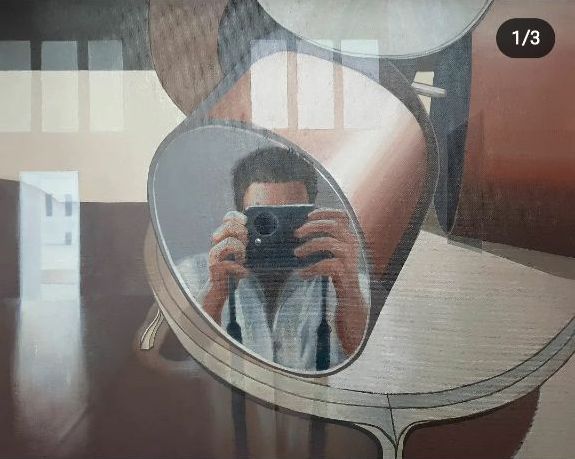
I’m now embarrassed as well as humbled because Katya did me a tremendous honor, one that I’m not even sure I deserve, and I kind of feel like I’ll never be able to thank her enough.
Steve
|